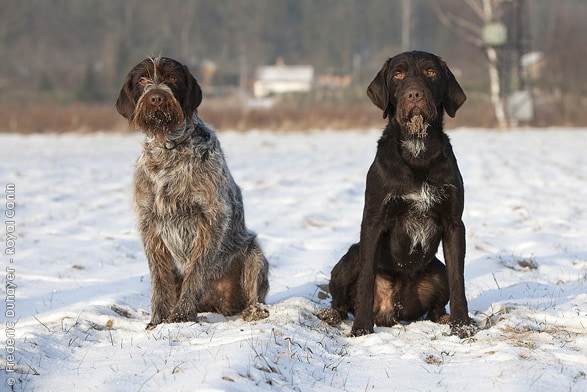Type the name of the breed you're looking for below
[wpdreams_ajaxsearchlite] Don't see the breed your're looking for? Click here and let us know!
Breed Characteristics
1 paw - breed exhibits the least amount of this characteristic
5 paws - breed exhibits most amount of this characteristic
Cesky Fousek
| Other Names | Bohemian Wirehaired Pointing Griffon, Czech Coarsehaired Pointer, Slovakian Wirehaired Pointer, Rough-coated Bohemian Pointer |
| Country of Origin | Czech Republic |
| Weight | Males: 61 - 75 lbs. (28 - 34 kg) Females: 48 - 61 lbs. (22 - 28 kg) |
| Height (at withers) | Males: 23½ - 26 in. (60 - 66 cm) Females: 22 - 24½ in. (58 - 62 cm) |
| Coat | The coat consists of three types of hair:• Undercoat: Soft and dense, 1.5 cm long. Prevents dampness penetrating to the skin and is almost completely shed in the summer.• Topcoat: 3 to 4 cm long, suitably harsh and coarse. Close fitting. • Guard hair: 5 to 7 cm long, especially harsh and straight. Particularly noticeable on fore chest, topline, flanks and shoulders. On the front part of the front and hind legs, the coat is shorter and coarse; it is longer on their rear side, forming feathering. The tail must not have a brush on the underside. Coat on head: On lower jaw as well as on lips, the hair is longer and softer, forming the beard, typical on this breed. The hair on the eyebrows points obliquely and noticeably upwards. The forehead, cranial region and cheeks are covered by short, coarse hair. Leathers are covered by short, softer, smooth hair. |
| Colour | Permitted colors are dark roan with or without brown patches. Brown with ticked markings on fore chest and lower part of the limbs. Brown without any markings. |
| Litter Size | 3-6 Puppies |
| Life Span | 12 - 15 Years |
| Origin & History | Formerly from Czechoslovakia, now the Czech Republic, the Cesky Fousek was the most widely kept wirehaired Pointing dog in the region of the present day Czech and Slovakian Republics in the time before the first World War. This World War and its consequences were responsible for the Cesky Fousek nearly dying out in the Twenties. The regeneration of the breed was implemented. The foundation for this regeneration was brought about by some of the original typical specimen from which the modern type of Cesky Fousek was evolved by planned breeding. At present its numbers are in second place for all hunting breeds used in the Czech and Slovakian Republics. The Cesky Fousek is a gundog belonging to the family of wirehaired pointers of Continental Europe. |
| Personality | The Cesky Fousek is very energetic, smart and willing to please. Cheerful and friendly, he likes children. Loyal and protective, he loves all family members equally, especially if they are carrying the leash, car key, gun or Frisbee. They are very people-oriented, and not happy if isolated from the family. If exercised sufficiently once or twice a day and given calm, but firm, confident and consistent authority, the Cesky Fousek makes a very agreeable family companion. If left to his own devices for long periods without exercise or leadership, he can become destructive and nervous. If raised with other dogs and cats from puppyhood, the Cesky Fousek does quite well. A hunting dog by nature, they are bred and trained to work in the field, forest and water. This breed has a natural keen hunting instinct to go on point, stretching his body long, taking in the scents. These are noble and gentle, easy to train dogs. They have all the qualities one could wish for in a hunting partner and 700 years of breeding to back them up. This breed likes to bark and needs to be told enough is enough if it becomes a nuisance. Socialize them well to prevent them from becoming reserved with strangers. |
Care Requirements
| Health | No known breed specific health issues. |
| Grooming | The coat of the Cesky Fousek is very easy to groom. Just brush regularly with a firm bristle brush and bathe only when necessary. A rub with a piece of toweling or chamois will leave the coat gleaming. Check the feet also, especially after the dog has been exercising or working. Dry the dog thoroughly after hunting to prevent chilling. Examine the ears regularly. This breed is an average shedder. |
| Exercise | Exercise is of paramount importance for these tireless energetic animals. They are more than a match for even the most active family and they should not be taken on as family pets unless they can be guaranteed plenty of vigorous exercise. They would be great for the person who hikes or jogs. On days they are not taken for a hike or a jog, they need a daily, long walk. When walking or jogging be sure to make the dog heel beside or behind the person holding the lead, as in a dog's mind the leader leads the way, and that leader needs to be the humans. If under-exercised, this breed can become restless and destructive. |
| Other Considerations | This breed is not recommended for apartment life and does best with a large yard and an athletic family. At least a 6-foot high fence is necessary. Bored Cesky Fouseks can become escape artists. Does well in most climates. |



